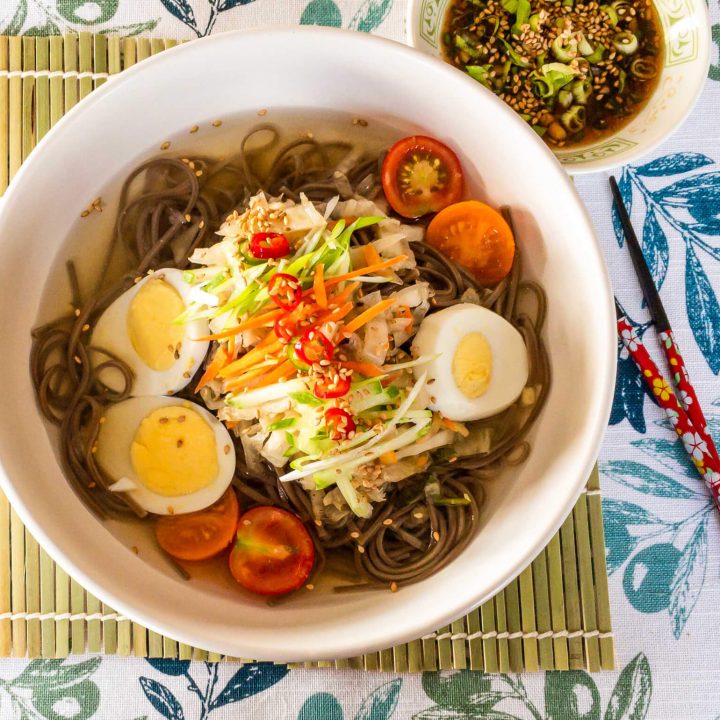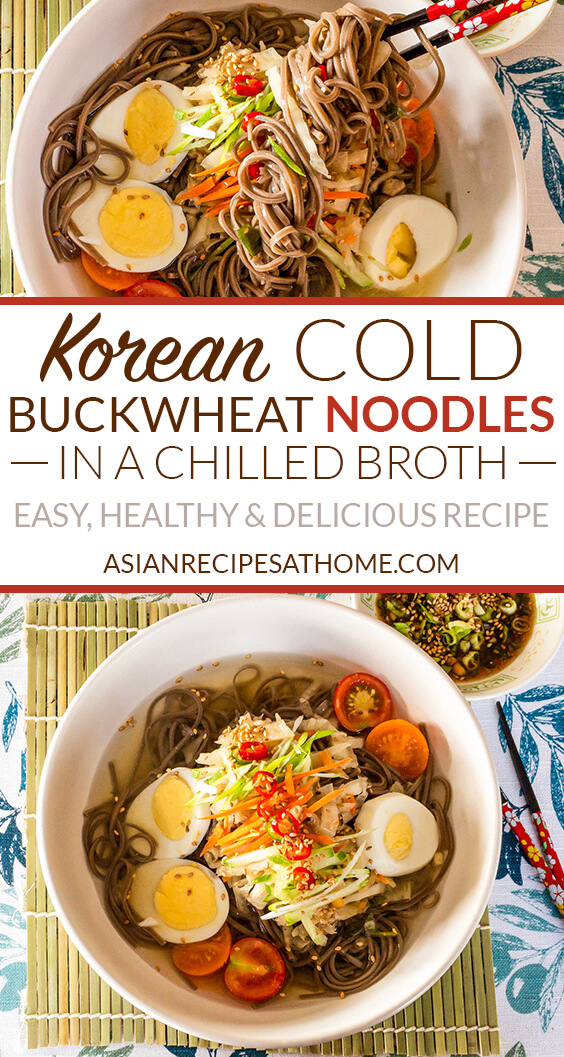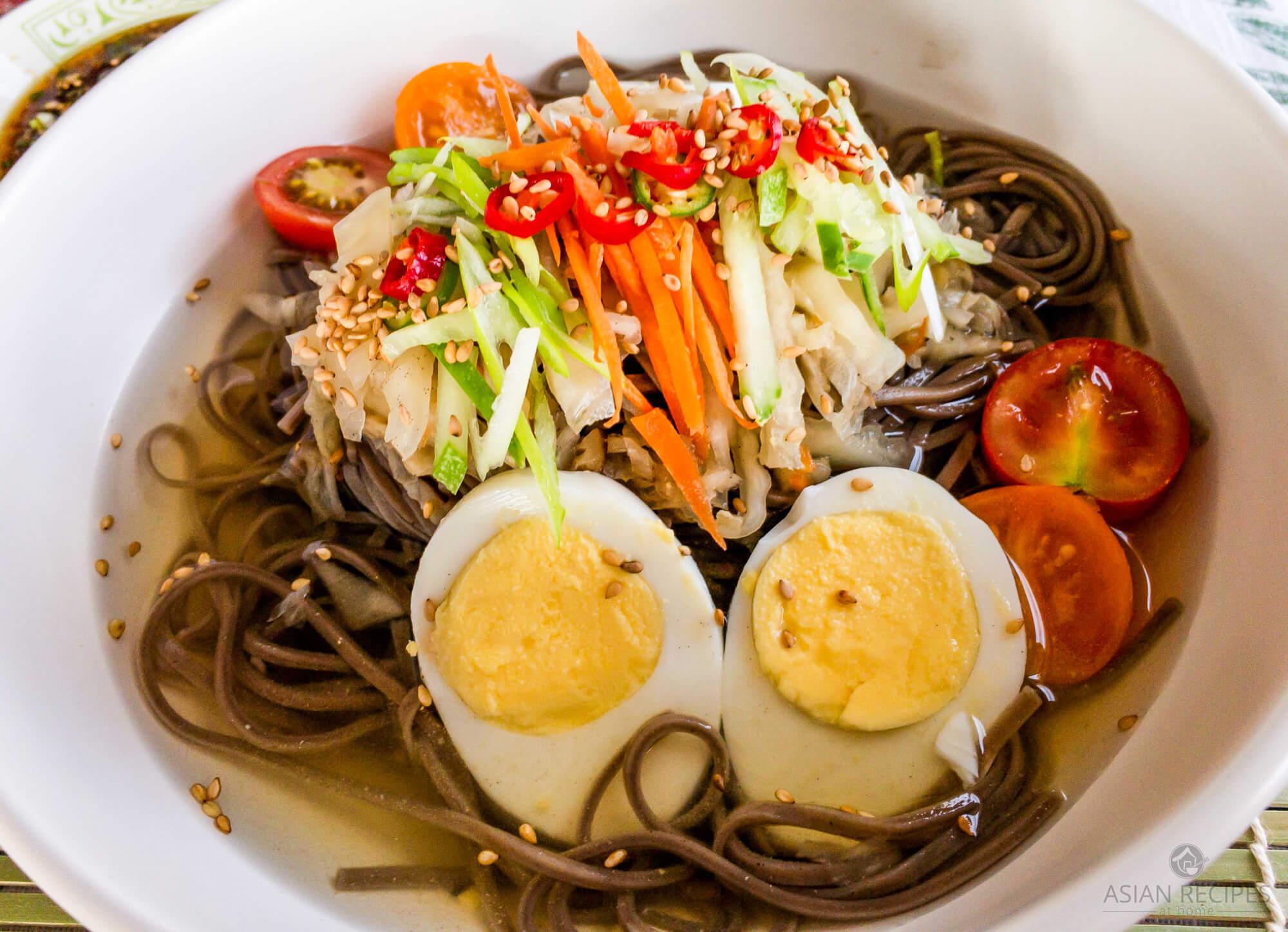Korean-style cold buckwheat noodles served in a delicious chilled broth. We made this homemade broth from Kombu seaweed, dried anchovies, and juices from white kimchi. This is a light, refreshing, and the perfect meal to eat on a hot day.
We are still experiencing hot temperatures during these last several days of summer. And this chilled noodle bowl is a perfect meal to cool you off. There are many different variations of Korean cold noodles recipes online. There are even some packages of noodles that include pouches of premade broth. These pouches of premade broth are popular in Korea for a really quick and easy meal.
Homemade broth
We made our own homemade broth for this recipe. Making this broth is worth it and it really doesn’t take that much extra time to make it. We are using Kombu seaweed, juices from a batch of white kimchi, and dried anchovies to make an umami filled and slightly tangy broth. Just remember, you will need to prepare this broth a little ahead of time to allow it to chill before assembling the noodle bowl.
Key features and tips
We highly recommend using the liquid from a batch of white kimchi for this recipe. You can use our recipe here if you’re up for the task of making a batch of white kimchi for yourself. You won’t be disappointed and you will be able to use it for this recipe and have it ready to go every time you have a kimchi craving. You might be able to get a similar result by mixing up some water, salt, and white vinegar or rice vinegar in a pinch instead of using the liquid from a batch of white kimchi. However, we have not tested that out yet ourselves, so we can’t confidently recommend a substitute for the white kimchi liquid at this time.
We top these cold noodles with sliced white kimchi, fresh cucumbers, carrots, and green onions. This is a very light and mild cold noodle bowl. It’s perfect for anyone who doesn’t tolerate spice well, and is even good for children. If you’re wanting a spicy cold noodle bowl, be sure to check out our Korean Cold Noodles with Spicy Sweet and Sour Gochujang Sauce recipe.
Ingredients needed to make this cold buckwheat noodle bowl
- Buckwheat noodles
- Eggs
- Cherry tomatoes
- Pickling cucumber
- Carrots
- Green onions
- Dried anchovies
- Kombu seaweed
- White kimchi
- Liquid/juice from white kimchi
- Salt
- Rice vinegar
- White sugar
- Water
- Toasted sesame seeds
How to make these cold Korean noodles
Step 1: Hard boil the eggs
First, let’s prepare the eggs. We want hard-boiled eggs for this recipe. Boil the eggs for about 10 minutes, remove the eggs and place in a cold-water ice bath. Once the eggs are cooled, cut them in half and set aside for later.
Step 2: Make the clear broth
Put water, dried anchovies, kombu seaweed, and salt in a medium/large-sized pot and place it on the stove burner, and set the temperature to high heat. Once the broth comes to a boil, remove the anchovies and kombu seaweed and discard. Turn off the heat and remove the broth to cool.
Once the broth is cooled, add the juice from the white kimchi, rice vinegar, and sugar. Stir well.
Step 3: Cook the noodles
Cook the noodles according to package directions. Once noodles are cooked, rinse the noodles with cold water.
Step 4: Top the noodles with fresh vegetables and enjoy
To serve, place a serving of noodles into a bowl and pour some of the cold broth on top of it. Place a serving of cucumbers, carrots, green onions, and white kimchi on top. Sprinkle with toasted sesame seeds.
We hope you enjoy our Korean Cold Buckwheat Noodles in a Chilled Broth recipe!
Want more noodle recipes?
- Korean Cold Noodles with Spicy Sweet and Sour Gochujang Sauce
- Best Korean Warm Noodle Soup
- Upgraded Instant Ramen Recipe Hack
HUNGRY FOR MORE? Subscribe to our newsletter and follow along on Facebook, Pinterest, Twitter, and Instagram for all of the latest updates.

Korean Cold Buckwheat Noodles in a Chilled Broth
Korean-style cold buckwheat noodles served in a delicious chilled broth. We made this homemade broth from Kombu seaweed, dried anchovies, and juices from white kimchi.
Ingredients
- 4 servings buckwheat noodles
- 2 large eggs
- 8 cherry tomatoes, cut into halves
- 1 cup pickling cucumber, julienned
- ½ cup carrots, julienned
- ½ cup green onions, thinly sliced on the diagonal
- 4 large-sized dried anchovies
- 2 2-inch pieces (15g) Kombu dried seaweed
- 1 cup white kimchi, thinly sliced (see our recipe)
- 1 cup liquid from white kimchi
- 1 tsp salt
- 1 Tbsp rice vinegar
- 1 Tbsp white sugar
- 5 cups of water
- 2 tsp toasted sesame seeds
- 1 cayenne chili pepper (optional), thinly sliced
Instructions
- First, let’s prepare the eggs. We want hard-boiled eggs for this recipe. Boil the eggs for about 10 minutes, remove the eggs and place in a cold-water ice bath. Once the eggs are cooled, cut them in half and set aside for later.
- Put water, dried anchovies, kombu seaweed, and salt in a medium/large-sized pot and place it on the stove burner, and set the temperature to high heat. Once the broth comes to a boil, remove the anchovies and kombu seaweed and discard. Turn off the heat and remove the broth to cool.
- Once the broth is cooled, add the juice from the white kimchi, rice vinegar, and sugar. Stir well.
- Cook the noodles according to package directions. Once noodles are cooked, rinse the noodles with cold water.
- To serve, place a serving of noodles into a bowl and pour some of the cold broth on top of it. Place a serving of cucumbers, carrots, green onions, and white kimchi on top. Sprinkle with toasted sesame seeds. Add sliced cayenne chili pepper if you want a bit of spice, this is optional.
- Serve and enjoy!
We love seeing your creations from our recipes! Tag us on Instagram at @AsianRecipesAtHome.
Disclaimer: Under no circumstances shall this website and the author(s) be responsible for any loss or damages resulting from the reliance of the given nutritional information or ingredient/product recommendations. Recommended ingredients/products can change their formula at any time without this website and author’s awareness. It is your responsibility (the reader’s) to check the label/ingredients of any product prior to purchasing and/or using. We greatly appreciate your support and understanding.



